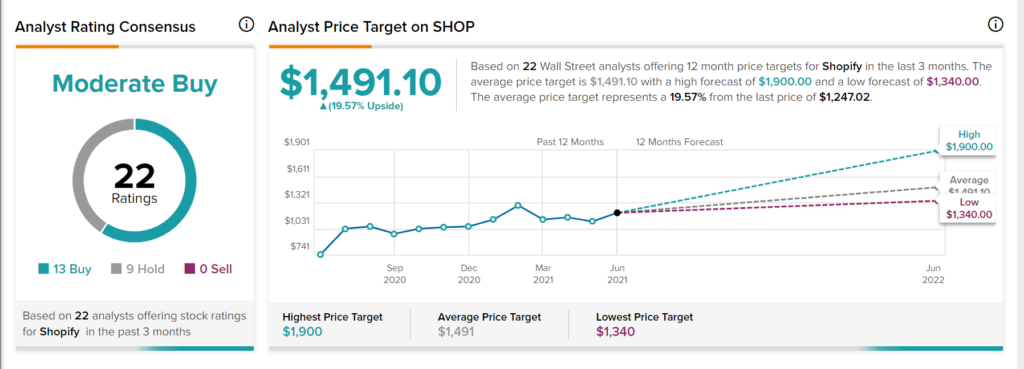For investors in hyper-growth stocks like Shopify (SHOP), recent weeks have provided some significant volatility. Shopify stock has ebbed and flowed between a relatively consistent range of $1,000-$1,300 per share over the past three months. Currently, Shopify trades at roughly $1,200.
Invest with Confidence:
- Follow TipRanks' Top Wall Street Analysts to uncover their success rate and average return.
- Join thousands of data-driven investors – Build your Smart Portfolio for personalized insights.
Now, it’s worth noting that this stock is still down approximately 20% from its all-time high of nearly $1,500 per share seen earlier this year. Indeed, sorting out whether this recent dip in SHOP stock is worth a buy is the main concern for most investors. (See Shopify stock analysis on TipRanks)
For long-term growth-focused investors like Cathie Wood, Shopify has been a top buy of late. Ms. Wood has compared Shopify to e-commerce juggernaut Amazon (AMZN), a rather flattering comparison.
Let’s take a look at whether Shopify’s got similar growth potential over the long-term.
Growth Is the Name of the Game for Investors in SHOP Stock
Indeed, the most common comparison for Shopify right now happens to be Amazon. When Cathie Wood points out the similarities, investors take notice.
From a valuation perspective, Shopify’s current multiples may seem obscene. Indeed, even compared to Amazon, a company with a historically-high multiple, Shopify trades at nosebleed levels.
Accordingly, let’s take a look at how these companies stack up. Here’s a look at a few key metrics:
Shopify’s trailing price-to-sales ratio is 45, and Amazon’s is 4. Shopify’s trailing price-to-earnings ratio is 96.2. Amazon’s is 62.
Shopify’s EV/EBITDA is 83.6, while Amazon’s is 27.6.
When it comes to trailing gross margins, Shopify’s is 10.5%, versus Amazon’s at 7.1%. Net margins of the two companies have a far wider gap, with Shopify at 46.7% and Amazon at 6.4%.
Revenue growth rate of Shopify is more than double that of Amazon. Shopify’s is 99.6%, and Amazon’s is 41.5%.
Now, on a price-to-sales basis, we can see that Shopify is currently valued more than 10 times higher than Amazon. On a price-to-earnings and EV/EBITDA basis, this valuation gap is also significantly large.
Despite those promising numbers, looking at Shopify’s margins and growth rate is really where investors get excited. Shopify isn’t just growing – it’s growing very fast. And it’s doing so profitably. Very profitably.
Shopify’s stellar top- and bottom-line margins provide cash flow generation investors are betting will be used to fuel additional growth. As the company continues to monetize merchant revenues, while taking a slice of transactions made on its platform, Shopify is double-ending each transaction. These cash flows are similar to those of other large credit card companies, and Shopify’s valuation certainly reflects a similarly large moat.
Accordingly, gross merchandize volume (GMV) is a key metric investors will want to watch with Shopify. The extent to which transaction volumes increase on its existing platform will give an indication as to which direction profitability is headed. Even if revenue growth slows over time, as many analysts think it will, if Shopify’s GMV can grow, and if the company can capture a greater percentage on its GMV in percentage terms, Shopify could turn into a cash flow machine.
That said, there are risks to Shopify stock. Let’s take a look at some of the key things investors should be paying close attention to.
Rate of Growth Deceleration a Key Metric
Prior to the pandemic, Shopify’s growth rate had started to slow. This makes sense: the larger a company gets, the more difficult it becomes to maintain sky-high growth rates. Eventually, a company reflects the market, assuming it’s able to capture its maximum market share and expand its margins as widely as possible. Accordingly, at some point, Shopify will become a slow-growth mature company in a developed sector.
How soon we get there is the question. Indeed, a massive e-commerce boost courtesy of the pandemic has resulted in investors pressing pause on this discussion. Shopify’s recent quarterly year-over-year growth rates are insane. That said, in all probability, we’ll be back to the growth deceleration conversation shortly.
Investors will want to see revenue growth maintain and decelerate slowly over time, as it had in the past. Any rapid deceleration is a risk investors need to be aware of.
What Analysts Are Saying About SHOP Stock
According to TipRanks’ analyst rating consensus, SHOP stock comes in as a Moderate Buy. Out of 21 analyst ratings, there are 12 Buy recommendations and 9 Hold recommendations.
As for price targets, the average analyst Shopify price target is $1,491.10, with a 19.6 potential upside. Analyst price targets range from a low of $1,340.00 per share to a high of $1,900.00 per share.

Bottom Line
The extent to which Shopify can continue to bolster its moat by entrenching its customer base, creating higher switching costs, and building out its ecosystem so that its merchants won’t want to leave, remains to be seen. However, thus far, Shopify has done an incredible job in this regard.
Barring a rapid deceleration in the company’s top-line growth rate, SHOP stock looks like an excellent growth play today. It’s entirely feasible that Shopify could make new all-time highs this year, if growth stocks get a boost. For long-term investors, this near-term volatility should simply represent noise. This certainly holds true for those true believers in SHOP stock, such as Cathie Wood.
Disclosure: Chris MacDonald held no position in any of the stocks mentioned in this article at the time of publication.
Disclaimer: The information contained herein is for informational purposes only. Nothing in this article should be taken as a solicitation to purchase or sell securities.









